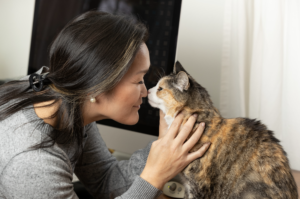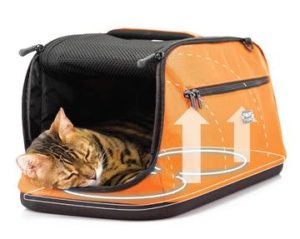Dr. Deirdre Chiaramonte

Deirdre Chiaramonte, DVM, CCRT, CVA is a Diplomat of the American College of Veterinary Internal Medicine and is certified in canine rehabilitation and acupuncture. She is a member of the AKC Canine Health Foundation Grants Committee, Delta Society Advisory Board, and current president of the New York City Veterinary Medical Association. Dr. Chiaramonte runs her own mobile vet practice.
Today’s domestic cats have never forgotten they are the descendants of the Jungle Cat. Despite the fact your feline friend is most likely sitting on the couch next to you, somewhere buried in their DNA is the original survival instinct of “show no weakness.” This inherent instinct to survive makes it extremely difficult to recognize pain in our cats at home.
 In truth, the vigilant cat owner can detect signs in behavior that are a tip off that something is changing. Most common behavioral differences surround mobility, agility, and a reluctance to jump up and down. If your cat normally greets you on the counter by your coffee maker, where is he today? If he is a part of your welcoming committee when you get home, winding his way in and out of your legs, where is he today? And why are his food and water dishes still full? If he is generally a social cat, always a part of the family, then where is he now? These abnormal behaviors are all key indicators that something is changing.
In truth, the vigilant cat owner can detect signs in behavior that are a tip off that something is changing. Most common behavioral differences surround mobility, agility, and a reluctance to jump up and down. If your cat normally greets you on the counter by your coffee maker, where is he today? If he is a part of your welcoming committee when you get home, winding his way in and out of your legs, where is he today? And why are his food and water dishes still full? If he is generally a social cat, always a part of the family, then where is he now? These abnormal behaviors are all key indicators that something is changing.
Much of the time, if a cat has a change in its normal behavior, it is either related to pain, illness, or a behavior problem usually related to stress. Common signs can be hiding, not wanting to be stroked or held, decreased intake in food and water, no desire to groom themselves and perhaps the behavior most noticed, lack of use of the litterbox. What is not always understood by the pet owner is this is NOT bad cat behavior, but rather a result of pain and the discomfort that is realized in positioning themselves to get into the box itself and then to crouch to defecate.
No one knows your cat’s usual behavior better than you! One helpful evaluation that can be done at home by a pet owner, is the use of a clinical metrology instrument, such as the Feline Musculoskeletal Pain Index (FMPI.) This is a mobility questionnaire filled out by the pet owner and rating categories go from normal to worse. It incorporates questions on pain, mobility, activity, affective effects and cognitive function. One such questionnaire can be found on painfreecats.org. The questionnaire can be completed over a few days while you are making notes, and it is an ideal tool to help you make decisions on the health of your feline.
 If the current changed behavioral issues, and the results of the questionnaire show any adverse signs, a trip to the veterinarian is in order. And be sure to take your FMPI survey with you. To facilitate your trip to the veterinarian, a Sleepypod® with the therapeutic Assisi Loop Lounge® inside should make the travel experience a happy one for your cat. Cats love the opportunity for Looping treatment in their enclosure, and when returning home, the carrier and its Loop Lounge continue to provide a place for comfort and healing. In-clinic the veterinarian can observe the cat in a resting position, watch its body carriage, check muscle mass and evaluate its gait. A thorough orthopedic exam, including manipulation of joints and radiographic evaluation, can confirm the suspicion of osteoarthritis. If it isn’t osteoarthritis, the veterinarian can rule out other causes of pain such as cancer, urinary infections, or obstruction, other infections, periodontal disease, digestive tracts issues, neurological disease, etc.
If the current changed behavioral issues, and the results of the questionnaire show any adverse signs, a trip to the veterinarian is in order. And be sure to take your FMPI survey with you. To facilitate your trip to the veterinarian, a Sleepypod® with the therapeutic Assisi Loop Lounge® inside should make the travel experience a happy one for your cat. Cats love the opportunity for Looping treatment in their enclosure, and when returning home, the carrier and its Loop Lounge continue to provide a place for comfort and healing. In-clinic the veterinarian can observe the cat in a resting position, watch its body carriage, check muscle mass and evaluate its gait. A thorough orthopedic exam, including manipulation of joints and radiographic evaluation, can confirm the suspicion of osteoarthritis. If it isn’t osteoarthritis, the veterinarian can rule out other causes of pain such as cancer, urinary infections, or obstruction, other infections, periodontal disease, digestive tracts issues, neurological disease, etc.
If pain or osteoarthritis is diagnosed, the dominant approach to treating pain in cats revolves around a multimodal approach. Among the options are NPAIDS, (non- pharmaceutical anti-inflammatory) such as the Assisi Loop®. The Loop or Loop Lounge with its FDA cleared tPEMF™ signal, provide reduction in pain and inflammation, accelerate healing, and of course, NO PILLING. Other cornerstones for a good outcome are analgesics, supplements, multi-modalities, exercise, and weight optimization. It is important not to treat your cat with any over the counter medications without first checking with your veterinarian.
Additionally, at home, small modifications can help, such as moving food dishes to more accessible areas, changing litter boxes to those designed with lower sides, placing carpet on slippery surfaces, to name a few.
Look for changes in behavior and resolve them; it will add years of pleasure for you and your cat.
